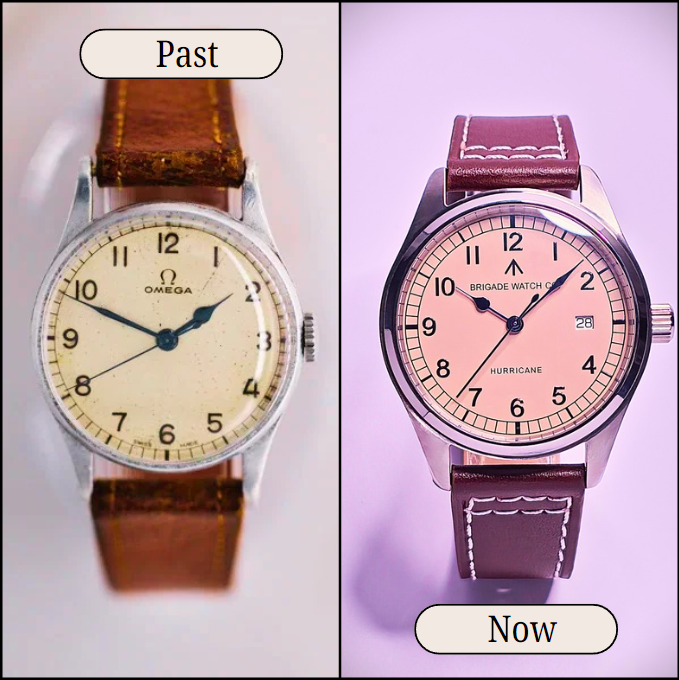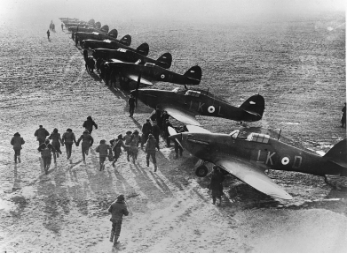
The History of the 6B/159 Pilot Watch
As the late 1930s approach, you are a pilot, acutely aware of the impending global conflict that looms large. The air itself vibrates with a palpable tension, a heavy quietude preceding the distant sounds of aircraft engines. The British Air Ministry, anticipating war, intensifies its focus on the essential equipment crucial to the Royal Air Force's operational capacity. Piloting an aircraft is more than merely occupying a machine; it is a precarious ballet of metal and human determination. Often flying alone, navigating hostile skies, your very survival and the mission's fulfillment hinges on executing every action with unwavering accuracy and precision.
It was amid this desperate necessity, as the early 1940s unleashed the relentless fury of the Blitz and sustained aerial combat, that the British Air Ministry embarked on a critical mission. They needed a new, purpose-built timepiece. The demand for a truly reliable and standardized watch wasn't just a preference; it was paramount. Earlier pilot watches, while functional, simply couldn't stand up to the brutal realities of combat. They lacked the sheer resilience, pinpoint accuracy, and unyielding readability demanded by rapid changes in altitude and temperature, intense vibrations, and the sudden, brutal G-forces of a dogfight.
The unforgiving environment of a wartime cockpit—often unheated, exposed to moisture, dust, and constant movement—quickly exposed the limitations of timepieces not specifically designed for such rigors. The Air Ministry understood this profound truth: A watch wasn't just an accessory; It was a lifeline, forging the necessity for the 6B/159 standard.

Image 1: Spitfire aircraft in flight

Image 2: Pilots walking to their aircraft
The 6B/159 timepiece resulted from meticulous planning, not chance. Designed with the wartime airman's needs in mind, it demanded exceptional readability in any light, rugged resilience against harsh impact, unwavering second-by-second precision, and the fortitude to endure the rigors of aerial combat. More than just another watch, it was a purpose-driven instrument, a fundamental tool designed for an incredibly perilous role.

Image 3: Close-up of a vintage 6B/159 Pilot Watch
Watches adhering to the 6B/159 stringent standards became available to aircrews within the Royal Air Force cockpits starting in 1938, 1 year before the official start to Britain's entry into WWII. They featured the now-celebrated tan dial - often affectionately called 'tropical' or 'military tan' - chosen for its striking contrast with the bold, black Arabic numerals. Distinctive blued steel spade hands swept across the dial, ensuring immediate recognition and clarity. This design was not merely stylistic; it was a crucial element for rapid legibility, enabling pilots to obtain critical information in fractions of a second during high-speed aerial maneuvers or amidst the dimness of bombing runs over occupied Europe.
The 6B/159 became more than an instrument; it was vital for dead reckoning navigation, allowing airmen to plot courses and determine their location long before the advent of modern GPS. Its role was paramount in coordinating complex missions with various squadrons throughout the UK, timing bombing runs with exacting precision, and ensuring seamless squadron synchronization over vast distances. Its robust, shock-resistant build and finely tuned mechanisms guaranteed relentless accuracy, cementing its place as an indispensable tool for Allied airmen navigating the tumult of war.
What Was the 6B/159? Decoding a Military Secret

The designation 6B/159 wasn't a hidden military secret, but rather a reflection of the British Air Ministry's structured inventory system. Picture the military's needs as an extensive catalog with everything neatly organized, and that's essentially what this system was. The "6B" label indicated air navigation equipment, placing it alongside sextants and compasses. In contrast, "159" was the specific identifier for pilot's wristwatches, differentiating them from other instruments in the same category.

Image 5: Various Company's 6B/159 Pilot Watches
The Air Ministry laid out incredibly precise requirements for the 6B/159 standard, detailing everything from the dial's size and layout to the movement's accuracy and the case's durability. Picture a comprehensive blueprint, distributed among trusted manufacturers, specifying every curve, material, and performance benchmark. Esteemed watch manufacturers of the era—including names like Omega, Longines, Jaeger-LeCoultre, and LeCoultre—were then tasked with producing watches that fulfilled these exacting specifications.
Though each manufacturer incorporated their own robust movements and might have included subtle, almost imperceptible variations in case finishing, they all strictly followed the same core design principles and functional requirements driven by military necessity. This standardization, designed in late 1939 and early 1940 and quickly implemented as the war escalated, guaranteed that every 6B/159 watch delivered the consistent, predictable, and utterly reliable performance crucial for wartime operations, no matter its watchmaker.
Why Was the 6B/159 So Important for Its Time?
The British military desperately needed a solution to a chaotic problem: a complete lack of standardization in available watches. It was impractical to equip personnel with a jumble of unique timepieces, each performing differently. Instead, they required one thoroughly tested specification. This would ensure that every watch supplied, regardless of its maker, shared the same characteristics, behaved consistently, and was fully interchangeable. This urgent need gave birth to the 6B/159 standard. It became a universal military specification, providing a common benchmark that delivered consistent, predictable performance from every single watch issued, whether it was produced by a renowned Swiss or British manufacturer. The result was profound: a pilot, facing the unforeseen, could pick up any 6B/159 watch and rely on it without question. This unwavering trust was essential, especially when both life and mission were on the line.

Image 6: Rolex Air-King
From History to Your Wrist: Brigade Watches' Connection and Our Modern Upgrades
The enduring legacy of the 6B/159 deeply resonates with us at Brigade Watch Co. As lovers of watches and their histories, we've observed that the 6B/159 remains a highly coveted configuration among collectors and enthusiasts, underscoring its timeless design and historical significance. We knew this iconic aesthetic was ready for a comeback, not as a fragile artifact, but as a durable, trustworthy timepiece and an accessible adventure watch built to withstand an active lifestyle. Our decision was to produce the Hurricane Sandstrike Variant as a respectful homage to the original 6B/159, blending its vintage appeal with essential modern enhancements for today's rigorous performance demands.
The spirit of the 6B/159 flows directly into our Hurricane Sandstrike Variant. We never intended to make a simple reproduction or a shallow imitation. Our ambition was to capture its core identity and functional spirit, all while making it vastly more comfortable for everyday wear and incredibly reliable for the long haul. Here's how we carefully balanced its storied past with the demands of the present:
-
The Movement:
The original 6B/159 watches featured manual-winding movements, which, while historically significant, require daily winding and frequent servicing. For the Hurricane series, the reliable Swiss-made ETA 2824-2 automatic movement was chosen. This modern movement offers superior reliability, accuracy, and ease of servicing globally. With a frequency of 28,800 vph, it provides a smoother second-hand sweep and simplified user experience due to its self-winding mechanism and 38-hour power reserve, surpassing the maintenance demands of vintage 6B/159 watches.

6B/159 Pilot Watch's Movement
Hurricane Sandstrike Variant's Sellita ET 2824-2 -
The Crystal:
Like almost all watches produced during WWII, the original 6B/159 featured a Plexiglass (acrylic) crystal. You might wonder why, especially since early forms of sapphire crystal were starting to appear in limited, high-end applications as far back as the 1930s. The military's choice was purely pragmatic: Plexiglass was incredibly cheap to mass-produce for wartime needs, very lightweight, and, critically for military use, virtually shatterproof. When impacted, Plexiglass tends to crack or deform rather than shattering into dangerous fragments that could harm a pilot's eyesight, as glass or sapphire would. This might sound unusual, but it was a crucial safety feature for a pilot in a confined, high-stakes cockpit.
The main downside of Plexiglass is its softness. Rated a mere 3 on the Mohs hardness scale, it's highly prone to scratching from everyday items (for context, your fingernail is about 2.5 Mohs, and common metals like keys are 5-6). For our Hurricane Sandstrike Watch, we wanted to significantly improve durability and clarity. That's why we've equipped it with a tough, scratch-resistant sapphire crystal. Sapphire boasts an impressive 9 on the Mohs hardness scale—nearly as hard as you can get, second only to diamond (10 Mohs). This drastically boosts visibility, and you won't see everyday scratches; your watch will remain pristine, undamaged, and easily legible for years, shrugging off the bumps and scrapes that would quickly age a vintage-style crystal.

6B/159 Pilot Watch
Hurricane Sandstrike Variant -
The Case and Crown:
The original 6B/159 watches, built to wartime specifications, often used chromium-plated brass or less durable alloys to conserve strategic resources. Our goal, however, was to create a watch far more robust and better suited for today's active lifestyle. That's why we've utilized a durable 316L stainless steel case, an industry standard renowned for its exceptional strength and corrosion resistance in contemporary watchmaking. It's built to withstand the elements and the rigors of daily wear.
A significant upgrade we made is the addition of a screwed-down crown. Many older military watches, including the original 6B/159, featured simple, pressure-fit crowns that offered only minimal splash resistance. For a watch intended for everyday life and water exposure—from casual rain and hand-washing to swimming—a screwed-down crown is essential. This feature comfortably makes our watch water resistant to a substantial 100 meters, offering you peace of mind to wear it in various situations while preserving the original's timeless and classic design appeal.
As a subtle and respectful gesture to the brave airmen who wore the originals, we've engraved our crown with the iconic RAF Eagle squadron insignia. We felt this symbol perfectly embodies and praises the spirit of courage, giving the watch a powerful connection to its heroic history.

6B/159 Pilot Watch
Hurricane Sandstrike Variant's RAF Eagle Insignia Crown Head -
The Hands and Dial:
Crucially, we've maintained the iconic blue spade hands that are synonymous with the original 6B/159, paying homage to its unique legacy. These hands create a beautiful and unexpected contrast against our new, cleaner tan Sandstrike Dial, resulting in a highly legible display that's both historically faithful and visually engaging. The "Sandstrike" finish provides a nuanced depth, perfectly blending the original's rugged, utilitarian charm with a more refined, tactile appeal for today's discerning wearer.

6B/159 Longines Pilot Watch
Hurricane Sandstrike Variant







